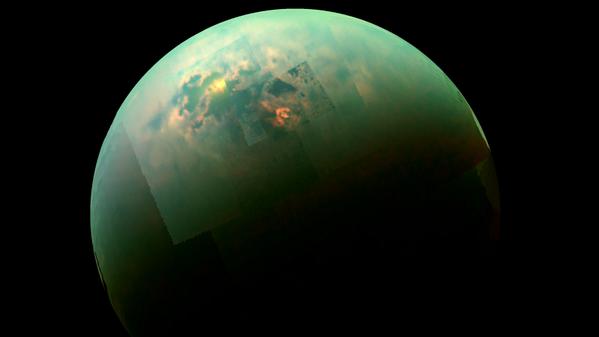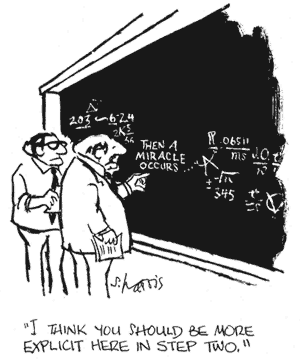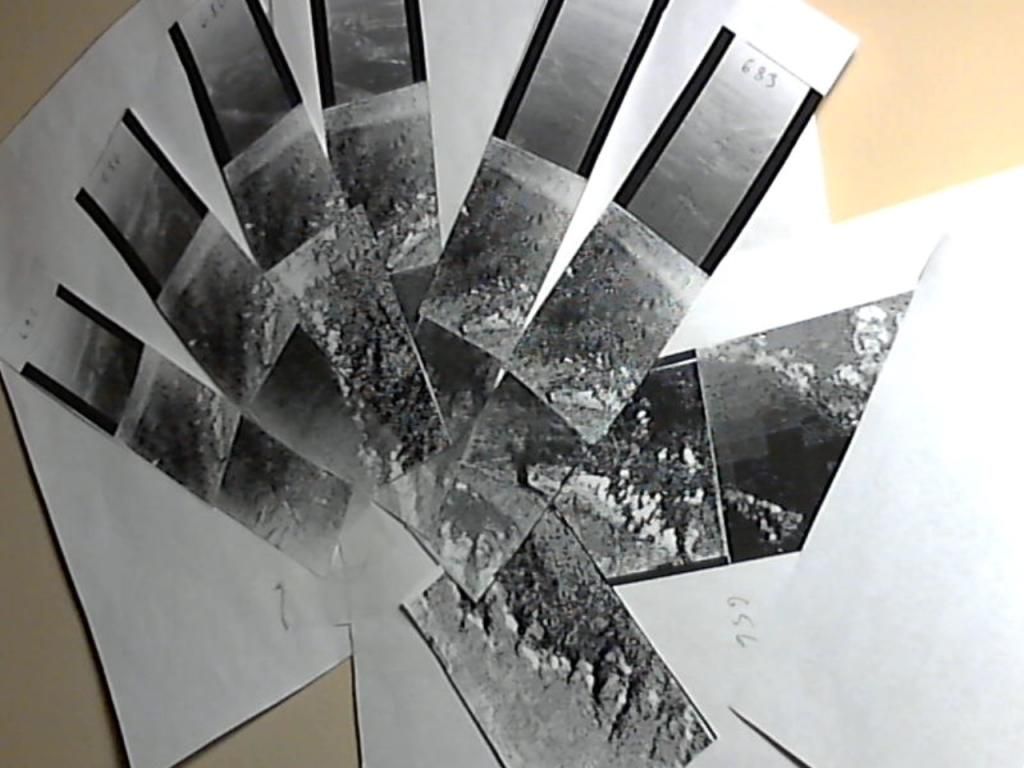
Posted on 11/06/2014 6:21:33 PM PST by lbryce

New images from NASA have captured the beautiful golden reflection of the sun on the polar sea of Saturn’s largest moon, Titan. It is the latest image from a collaborative four year mission studying the Saturnine system.
The mirror-like reflection, known as the specular point, is in the south of Titan's largest sea, Kraken Mare – just north of an island archipelago separating two separate parts of the sea. To the human eye, this would appear as a haze but through Cassini’s Visual and Infrared Mapping Spectrometer (VIMS), “real color information” is provided in wavelengths that correspond to atmospheric windows, making the moon’s surface visible.

"The highest resolution data from this flyby — the area seen immediately to the right of the sunlight — cover the labyrinth of channels that connect Kraken Mare to another large sea, Ligeia Mare. Ligeia Mare itself is partially covered in its northern reaches by a bright, arrow-shaped complex of clouds. The clouds are made of liquid methane droplets, and could be actively refilling the lakes with rainfall," stated NASA.

Titan is the only other body in the solar system known to have a liquid surface like Earth. Instead of water, the lakes and seas are made up of hydrocarbons, organic compounds that also rain down from the clouds that cover the moon. For this reason, scientists think that because Earth and Titan share so much in atmospheric composition, the Saturn’s moon might hold clues as to how the primitive Earth evolved into a life-bearing planet.

(Excerpt) Read more at rt.com ...
Maybe because God’s creations on Earth are discussed among the in-crowd as a result of “Mother Nature”. But there’s no Mother Nature in space.?
In “The Puppet Masters” by Heinlein wasn’t Titan where the parasites came from?
Do it if you can. Your mind will struggle with what you're seeing. Adjectives will fail you.
LISTER, near the navicomp hologram, has a robotic-style pool cue. He sets up so he can “shoot” through the hologram. He lowers the “cue” and drinks from a can.
RIMMER: How many of those are you going to drink?
LISTER: I told you not to talk. Game on.
RIMMER: You’re going to drink an entire six-pack of wicked-strength lager?
LISTER: I’m not gonna get plastered, Rimmer, just ... just nicely drunk.
RIMMER: Define “nicely drunk.” Is “nicely drunk” horizontal or perpendicular?
LISTER: Rimmer, I can handle it.
KRYTEN: I’m not sure I can.
LISTER: We’re in the wrong position. It’s an easier shot if we go over here. (He moves into the “better” position and lines up the shot.)
RIMMER: But that’s right in the orbital path of the planet! If you miss, we’re going to get a planet in the face.
LISTER: I’m not gonna mish.
RIMMER: “Mish?”
LISTER: What?
RIMMER: You said “mish.” “I’m not gonna mish,” you said. You’ve only had two cans and you’re steaming!
LISTER: Rimmer, will you relax? I know what I’m doing! I am not pished!
LISTER walks toward the cockpit and into the door. RIMMER covers his face
The Navicomp shows the hologrammatic view. The planets orbit their stars.
A flashback, in black and white — a pool table, midway through a game.
LISTER examines the table critically, drags on a cigarette, puts it in his ear, and lines up a shot.
Current; in colour — Starbug.
LISTER is lining up his “shot” on the Navicomp hologram. The flashback
LISTER fine-tunes his shot... The current LISTER fires his shot.
On the Navicomp, a solar flare leaps from the surface of the star, washing the blue planet out of orbit. A blue planet is enveloped in flame, and leaves its orbit. On the Navicomp, we see the hologrammatic blue planet heading straight toward the other star, missing the white hole by about half the width of the screen.
RIMMER: He’s missed.
On the Navicomp, the blue planet strikes the red planet, with a spark. The red planet is displaced.
RIMMER: We’re finished!
The hologrammatic red planet slingshots out of its orbit, toward the recently vacated-by-a-blue-planet star. Here it strikes the green. There is a flare of sparks, and the green is deflected out of its orbit
RIMMER: What the smeg is going on?
We see on the Navicomp that the green planet is heading straight toward the white hole.
LISTER: She rides!
The green planet shoots into the white hole, and it implodes to nothingness
RIMMER: You jammy goit!
LISTER: Played for, and got!
KRYTEN: Surely not, Sir!
CAT: Are you trying to say that was a trick shot?
LISTER: (Doing the touch-up shuffle) Intended! Pool God! King of the Cues! Prince of the Planet-Potters!
The first is the use of Einstein's formulas. They allow for very precise trajectory and orbit calculations which would not have been possible with the old Newtonian physics.
The second and most important aspect are TCMs or trajectory correction maneuvers. All missions allow for a number of these maneuvers in the cruise and approach phases of the mission. These TCMs ensure that they hit the right orbit when they arrive.


Sponsoring FReepers are contributing
$10 Each time a New Monthly Donor signs up!
Get more bang for your FR buck!
Click Here To Sign Up Now!
Wouldn’t it be more correct to say “scientists think that because EARLY Earth and Titan share so much in atmospheric composition...”
Who TH are you?!? ;’) Do I remember you, heh... I know I’m getting a little older, but c’mon...
Extra to APoD. That’ll be a relief, since we haven’t had the regular ones for a few days.
http://www.freerepublic.com/tag/titan/index
That's because the cities on Titan are built with Opal instead of stone or rock.
How about some more details.
In order to make the TCMs the spacecraft needs to determine quite accurately both its position and velocity.
I can understand how the apparent position of the stars will allow for determination of the orientation of the craft relative to the relatively fixed coordinate system of the stars.
The apparent positions of the planets would allow for the position to be determined. Tracking the position over time allows for the velocity to be determined; that is, both the direction of travel and the speed.
Does the typical spacecraft use a telescope to determine the positions of objects in its field of view? The stars will appear as single points. Does the craft use the edges of the planets when its proximity to them permits it?
The craft would need to find many points to verify its position and velocity. Does the craft use a mechanical system to measure the angles for a particular position of the telescope relative to the body of the craft?
I actually attempted to determine this information from a person involved in these space missions but I found his answer far too minimal and didn't want to embarrass him by finding that perhaps he didn't know the details.
Interesting...surprised about the city that looks like a Hammer and Sickle. I thought Socialism was an Earth-only problem.
To me, the Black Canyon of the Gunnison and Grand Canyon of the Yellowstone are more “spectacular”.
I can’t tell you how stupid I feel.

I wonder if it is really green or if that is added?
If you were there, Titan would be a bright blank disk to your eye. The caption explains that the colors are an encoding of the infrared spectrum used to get the images. Note also that the orange “specular” components are each from a separate angle, and merged in this composite, so it’s all kind of abstract, yet “real”.
The position and velocity of crafts is computed almost always on Earth. We use Doppler, radio interferometry and a host of other physics and maths tricks to get the position and velocity. Most of these procedures use the radio signals that these crafts send back to Earth.
The computers we send in space are programmed purposefully for the science mission and it would be far to wasteful to load them up with the heavy computations needed for obtaining a celestial navigation fix.
When these ships have cameras they are usually protected with entry shields and/or folded away during the cruise stage.
If a ship has navigation cameras, pictures are taken of planets and stars (like you theorized) but they are sent back to Earth for processing. Due to the limitations of imaging sensors if you want to see the planet’s edge the stars don’t show up. If you want to see the stars the planet is overexposed and looks like a white orb. Back on earth that can be processed and a precise fix can be calculated.
Thanks. That gives me a lot to think about.
I can see where precise values for speed and acceleration on a line directly away from the earth can be calculated.
One might use transit time of the signal to get absolute distance from the earth, for example.
I'm less clear on how speed and acceleration can be accurately determined at right angles from the line directly away from the earth.
Does the radio interferometry involve comparing the phase of signals received at different stations widely separated on earth, for example.
Is the determination of position and velocity at right angles to the line directly away from earth basically equivalent to viewing a picture of the sky and determining the apparent position of the craft relative to other objects in the field of view?
I think my difficulty may just stem from the possibility that the Doppler and similar techniques are so precise, that I am expecting similar precision for the apparent position in the sky, when perhaps such precision just isn't necessary to do the job.
I don’t remember this particular aspect when I was reading about this, but I struggle to think of cases in which our crafts travel for any significant amount of time perpendicular to our line of sight to them. By definitition this cannot happen for too long, because either the craft flies straight and we revolve or the craft has arrived and it revolves too. In the frist case the angle will not stay at 90 for too long, in the second case we see it straight on at regular intervals.
For the brief periods the ship might be perpendicular we can use intertial navigation.
The other thing is that I suspect geometry can be used pretty close to 90 deg. Cos(80) is still significantly large at 0.2.
Disclaimer: Opinions posted on Free Republic are those of the individual posters and do not necessarily represent the opinion of Free Republic or its management. All materials posted herein are protected by copyright law and the exemption for fair use of copyrighted works.